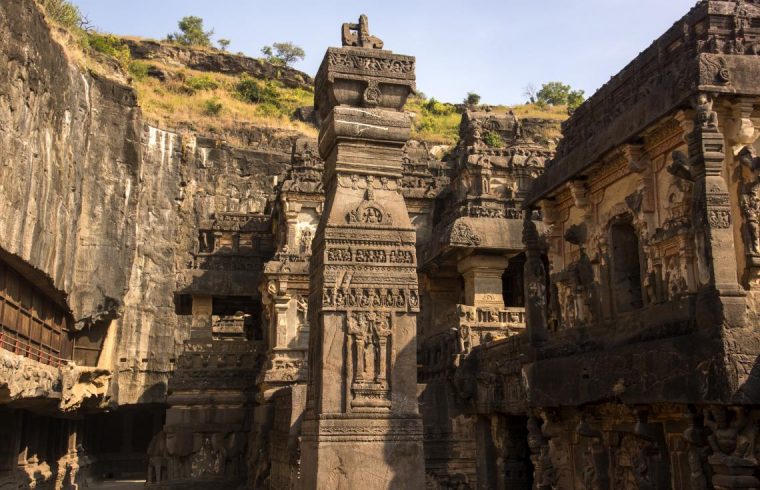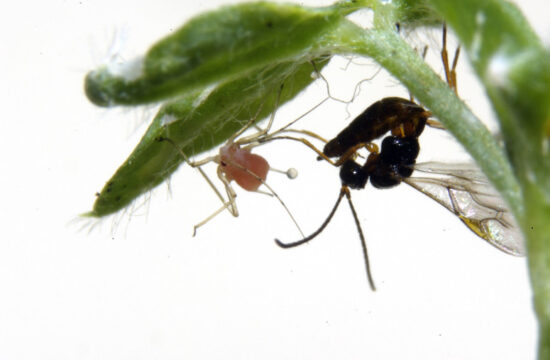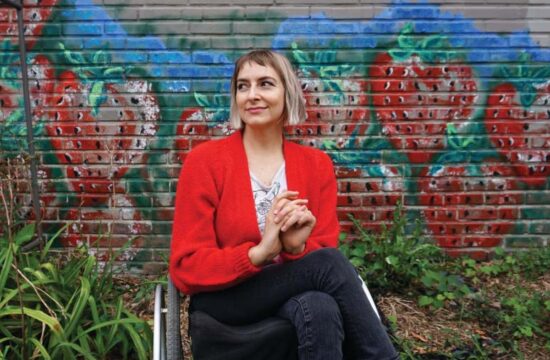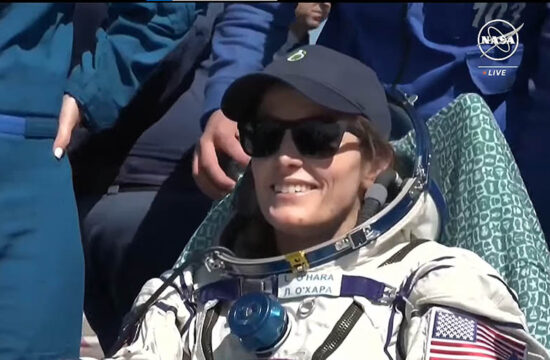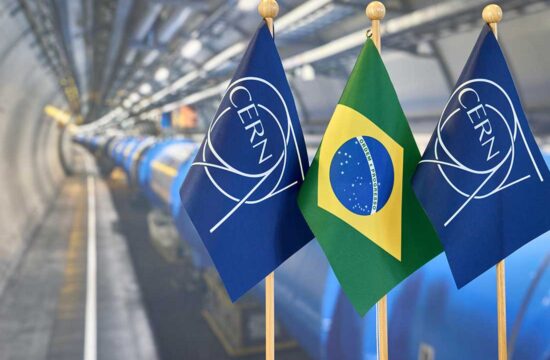Kailasanatha Temple, the temple was declared a UNESCO World Heritage Site in 1983 as part of the Ellora Caves complex. It is also known as the Kailasa and Cave 16, the Kailasanatha temple at Ellora is the largest monolithic rock-cut monument in the world.
At 32 metres high and 78 metres long, it is widely considered remarkable for its size, architecture and sculptural treatment. The temple is unusual in that it is not a recreation of interior spaces like earlier Deccan cave temples such as those at Badami and Ajanta. Rather, it is a rock-hewn rendition of a structural Shaivite temple executed as a freestanding form in a large open court. The temple’s design appears to have been appropriated or developed from the Chalukya Dynasty’s Lokeshvara or Virupaksha temple at Pattadakal.
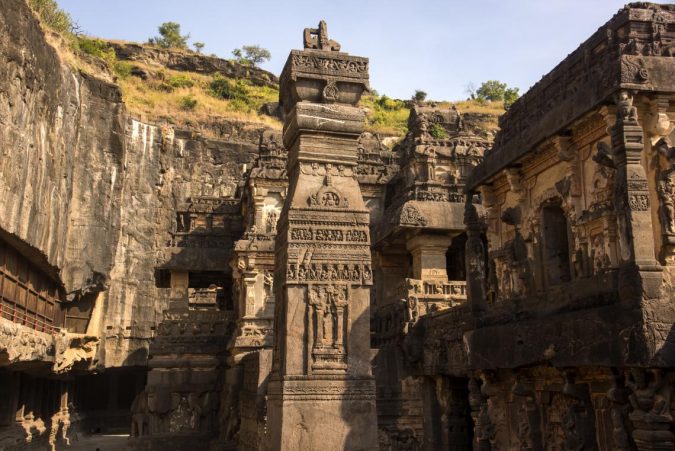
Scholars have suggested that this is meant to represent the victory of its patrons, the Rashtrakuta Dynasty, over the Chalukyas, their former sovereigns. The temple’s iconography is influenced by Shaivite myths as well as the avatars of Vishnu; many sculptures appear to have been selected based on themes of the successful upholding of cosmic order, supporting the claims of its patrons to political ascendancy over the Deccan.
Scholars initially believed that Kailasanatha’s diversity in sculptural styles, coupled with the scale of its excavation — requiring over two million tonnes of rock to be removed — meant that it must have been added to over the course of many generations, through the patronage of multiple dynasties.
However, the temple’s uniform architectural programme, combined with more recent studies of sculpture and iconography, have led to a new consensus attributing it to around two decades of activity under the Rashtrakuta kings Dantidurga and Krishna I in the late eighth century CE. The carving was most likely executed from the surface of the rock to the centre, from the top to the bottom. Additional halls and sculptures may have been added through the early ninth century.
The temple is entered through a two-storeyed rock-cut gateway or gopuram. Directly facing the entry is a carved panel of Gajalakshmi, generally associated with kingship, flanked by two colossal dvarapalas. Beyond this is an open courtyard 47 metres wide on average. Two free-standing elephant sculptures are positioned in a space adjoining the gateway, which transitions into a circumambulatory space around the temple proper through a short flight of steps.
The temple proper stands on a moulded plinth about 8 m high within this. Such a tall plinth is unusual for structural temples of this period, leading scholars to suggest that it was designed to allow for light and air to reach the bottom storey. The plinth is decorated with carved elephants and lions and appears to be influenced by models from Pallava sculpture; it has also been argued that sculptor guilds from Pallava territories may have been drawn to Ellora by Rashtrakuta patronage.
Large galleries are carved into the side and back walls of this enclosure, further increasing the space available for circumambulation at ground level. Scholars have argued that some of these — specifically the river goddess shrine carved into the northern cliff face and the sacrificial hall or yajnashala on the southern cliff face — might have been added by later Rashtrakuta monarchs. Other galleries, such as the sixteen-pillared Lankeshvara temple on the first storey of the northern cliff face adjacent to the temple, appear to have been a part of the initial excavation.
The upper storey of the Kailasanatha includes the temple proper, consisting of a Nandi mandapa; a sixteen-pillared sabhamandapa with porches on the north, west and south; the garbhagriha surmounted by a vimana with four talas; and five subsidiary shrines to the north, northeast, southeast and south of the vimana. Sculptural stone bridges connect the Nandi mandapa with the gopuram and the sabhamandapa; a bridge that originally extended from the sabhamandapa to the southern cliff face has since collapsed.
On the ground floor, on the lower exterior walls of the Nandi mandapa and the sabhamandapa, are large sculptures of Gajasurasamharamurti and a meditating Shiva facing each other. The southern lower exterior wall of the sabhamandapa is carved with detailed narrative friezes depicting the Ramayana, while the northern lower exterior wall is carved with the Mahabharata narrative. Both of these reliefs omit the beginnings and ends of the epics and include scenes not seen in the classical recensions, suggesting that the artisans and patrons of the temple used local or regional variations of the stories instead.
The sculptures on the south exterior wall of the sabhamandapa on the upper storey depict the abduction of Sita and the battle of Vali and Sugriva; the north includes various forms of Shiva. Scholars have suggested that this is meant to suggest a collapse and a restoration of cosmic order respectively, which in the temple’s iconographic programme appears to be closely linked with Shiva and by extension the Rashtrakutas as Shaivite kings.
Scholars have also suggested that the Kailasanatha collected and represented aspects of Shaivism that were still evolving in the eighth and ninth centuries: the galleries on the ground floor contain among the earliest known depictions of Ravana sacrificing his heads to Shiva, a legend that is directly linked to later jyotirlinga traditions.
The vimana of the Kailasanatha may be considered an example of the continuing evolution of Deccan temple architecture. It is surmounted by an octagonal shikhara over a platform with reclining bulls at four corners. In the three subsequent talas, the shrines at the centre of each side are crowned by barrel-roofed aedicules known as shalas, and those at the corners by square-shaped aedicules called kutas.
The overall elevation of the vimana shows a radial continuity by repeating the basic architectural scheme in each of the lower talas giving the impression that the whole vimana expands outward with each tala. A barrel-roofed antefix or sukhanasa extends from the vimana towards the roof of the sabhamandapa, a feature also seen at the Virupaksha temple at Pattadakal. The roof bears kuta aedicules at each corner interspersed with shala aedicules; at the centre is a lotus surmounted by four lions arranged around a central kuta. The lions’ bodies are pointed towards the ordinal directions, whereas their faces are turned towards the cardinal directions; it is possible that this is also meant to support claims to Rashtrakuta political ascendancy.
The sculptures at the temple are characterised by movement: plasticity and fluidity of form replaces the solidity and verticality seen in the sculpted volumes of earlier caves at Ellora, a trend first seen in the Dashavatara cave. This sculptural trend provides further art historical support to the attribution of the Kailasanatha to the Rashtrakutas, since the Dashavatara cave is directly associated with the Rashtrakuta king Dantidurga through an inscription.
The sculptors at the Kailasanatha appear to have moved away from older compositional styles emphasising the central axis of symmetry; the figures they produced are mobile and animated, as observed in the dvarapalas and the Gajasurasamharamurti. The sculptural depiction of Ravananugrahamurti under the sabhamandapa on the south side has also been remarked upon for its dramatic quality, with palpable psychological contrasts and tensions.
The multi-armed, multi-headed demon-king Ravana is carved completely in the round under a platform on which Shiva sits; the whirling motion of the demon is balanced by the stillness of Shiva. Like other sculptural depictions of Ravananugrahamurti, such as those seen at Pattadakal, this may be meant as a political allegory for the dominance of the Rashtrakutas over their rivals. However, the lack of inscriptional evidence from the temple itself makes such associations difficult to establish definitively; the only references to what may be the Kailasanatha temple are found in inscriptions from Rashtrakuta vassals.
The Kailasanatha temple continued to attract visitors, admirers and patrons for centuries after the collapse of the Rashtrakutas. These included various rulers of the Bahmani and Nizam Shahi dynasties, who visited the temples for recreational visits along with their courts; the Mughal emperor Aurangzeb Alamgir visited it in the late seventeenth century and in the eighteenth century, the Maratha queen Ahilyabai Holkar sponsored a renovation and the repainting of some sections of the temple.
Note: This article first appeared in the MAP Academy Encyclopedia of Art which encourages knowledge-building and engagement with the visual arts and histories of South Asia.


